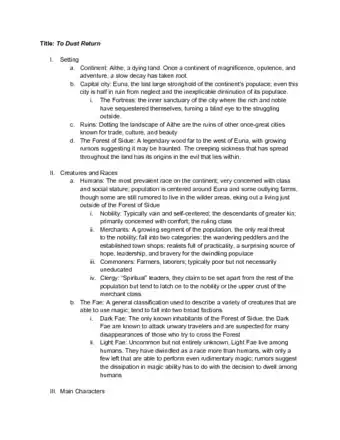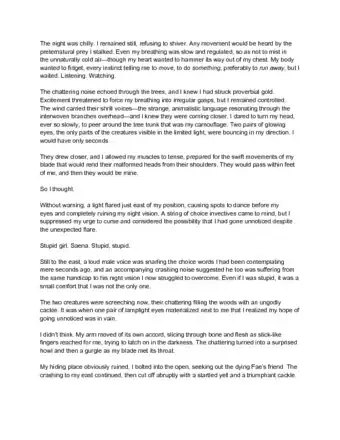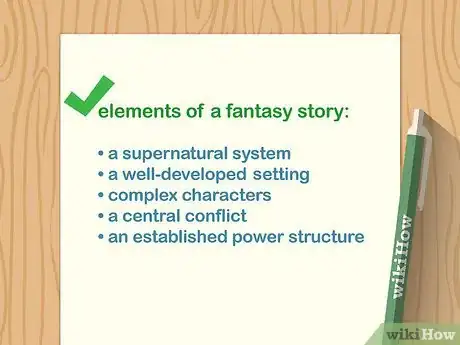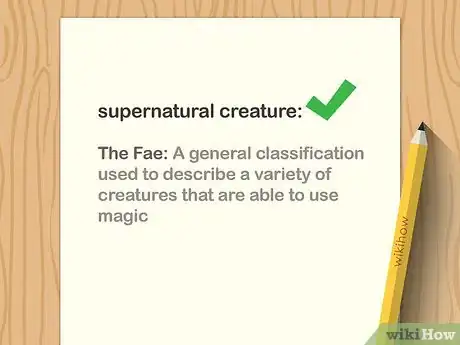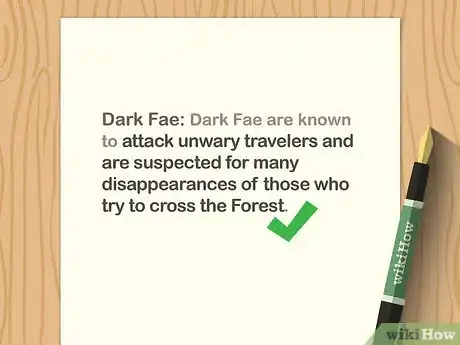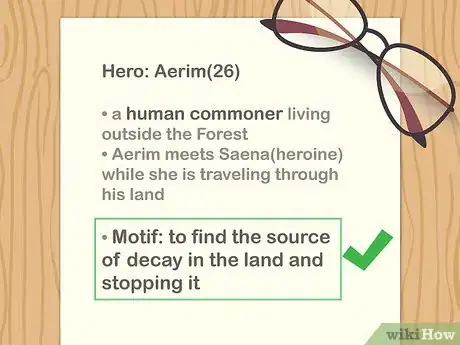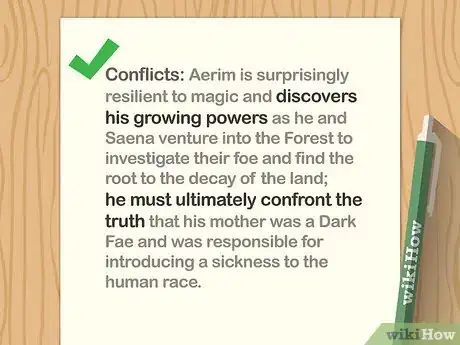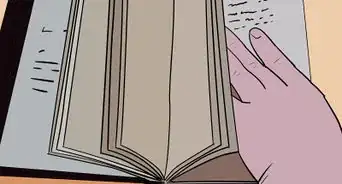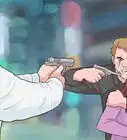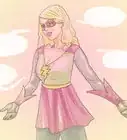This article was co-authored by Grant Faulkner, MA. Grant Faulkner is the Executive Director of National Novel Writing Month (NaNoWriMo) and the co-founder of 100 Word Story, a literary magazine. Grant has published two books on writing and has been published in The New York Times and Writer’s Digest. He co-hosts Write-minded, a weekly podcast on writing and publishing, and has a M.A. in Creative Writing from San Francisco State University.
There are 9 references cited in this article, which can be found at the bottom of the page.
wikiHow marks an article as reader-approved once it receives enough positive feedback. This article received 22 testimonials and 89% of readers who voted found it helpful, earning it our reader-approved status.
This article has been viewed 904,389 times.
Writing your own fantasy story is an incredibly rewarding process. To make the fantasy world seem realistic, describe the setting in detail, create some rules regarding magic and the supernatural, create interesting characters with realistic motives, and then write your story down. Have fun using your imagination to create a world that draws readers in!
Steps
Writing Help
Establishing Your Setting
-
1Describe the physical surroundings of your fantasy world. What does your fantasy world look like? If you want your story to feel realistic, you need to create a clear vision of your world for your readers.[1] Describe the sky, buildings, ground, and flora and fauna to help your readers imagine the world for themselves.[2]
- The setting of your story can be as broad or narrow as you like. For example, your story could be set in a town, city, planet, or universe.
- If your story is set in an actual place, explain this to your readers. For example, the Harry Potter series starts in modern England and transitions to a hidden world.
- Middle Earth in The Lord of the Rings is a good example of a foreign universe being explained.
- Incorporate all the senses into your description. What does it smell like, feel like, and look like?
EXPERT TIPJulia Martins is an aspiring writer currently living in San Francisco, California. She graduated from Stanford University with a BA in English and has been published in Cornell University's Rainy Day Magazine, Stanford University's Leland Quarterly, and Bards and Sages Quarterly.BA in English, Stanford University
 Julia Martins
Julia Martins
BA in English, Stanford University"Remember that "fantasy" is as big or as small as you want it to be," adds creative writer, Julia Martins. "You could create a secret magical society within our regular world (like JK Rowling did in Harry Potter) or you could create a whole complicated world of countries, cultures, and magic (like George RR Martin did in Game of Thrones). Either way, what makes fantasy "credible" is that you give your story the detail and care it needs to shine!"
-
2Draw a map, if it's helpful. Many famous authors included maps of their fantasy worlds in their work, such as JRR Tolkien’s map of Middle Earth, to help you imagine the setting. This is particularly useful if your fantasy world has multiple different locations in it or if your story includes a journey from 1 place to another. Draw a map on a piece of paper and include the major landmarks, cities, rivers, oceans, etc.[3]
- Draw a series of trees to represent the looming, mysterious forest in your world. Draw a star to represent the capital of each city. Draw ripples of water to indicate rivers, streams, and oceans.
- Even if you don’t include the map in the final copy of your story, it can help you to imagine the setting.
EXPERT TIPJulia Martins is an aspiring writer currently living in San Francisco, California. She graduated from Stanford University with a BA in English and has been published in Cornell University's Rainy Day Magazine, Stanford University's Leland Quarterly, and Bards and Sages Quarterly.BA in English, Stanford University
 Julia Martins
Julia Martins
BA in English, Stanford UniversityStruggling to come up with a map? Julia Martins, creative writer, tells us: "If you're struggling to draw a map, try taking a handful of uncooked macaroni pasta and tossing it onto a table. Trace around the pasta and you have a brand new coastline to use for your map!"
Advertisement -
3Describe the culture and the political setting of your world. This gives you great scope to use your imagination. Make note of details such as the political system, the currency used, common cultural practices, and the history of the place. This helps to give your world depth and makes it seem more realistic.[4]
- If you are creating your story in an actual place, describe any aspects of the place or culture that deviate from real life.
-
4Decide what level of technology your society has. Ground your fantasy world in a certain moment in time. If your fantasy worlds take place in the future, invent technological advances to make them seem futuristic. If you're writing something set in a more primitive society, include basic technologies, such as horses and carts instead of cars or hoverboards.[5]
- Research the technologies to make them realistic. For example, If you want to incorporate a cure for aging, read some articles on the process of aging. Understand how and why aging occurs so you can depict how it could be paused or stopped altogether in a fashion that feels realistic.
- If you want your story to take place in an ancient world, research how past cultures lived.
EXPERT TIPJulia Martins is an aspiring writer currently living in San Francisco, California. She graduated from Stanford University with a BA in English and has been published in Cornell University's Rainy Day Magazine, Stanford University's Leland Quarterly, and Bards and Sages Quarterly.BA in English, Stanford University
 Julia Martins
Julia Martins
BA in English, Stanford UniversityTechnology impacts the entire world you're building. Julia Martins, creative writer, tells us: "Fantasy stories aren't restricted to worlds with no technology. However, once you've decided what level of technology your world has, spend some time thinking about how that impacts the rest of the world. For instance, if your world doesn't have cars or trains, transportation is going to be much harder!"
Making the Rules
-
1Create social conventions if your story is set in a fantasy land. If you're creating your own world, describe the different social classes and conventions to make your world feel more realistic. Outline any distinct class systems to your reader and describe the common customs and rituals?[6]
- Many fantasy writers base social conventions on aspects from the real world. For example, most societies have rituals like birthdays, weddings, funerals, and holidays. Try to think of similar rituals for your own world. How do your characters celebrate growing older, for example? How do they mark death?
- Researching other cultures can be a great way to come up with ideas. Many fantasy writers borrow their ideas from older cultures or different cultures. Research rituals from ancient cultures or isolated cultures to help you gain ideas.
EXPERT TIPJulia Martins is an aspiring writer currently living in San Francisco, California. She graduated from Stanford University with a BA in English and has been published in Cornell University's Rainy Day Magazine, Stanford University's Leland Quarterly, and Bards and Sages Quarterly.BA in English, Stanford University
 Julia Martins
Julia Martins
BA in English, Stanford UniversityWrite more than you think you need. Julia Martins, creative writer, advises: "It's ok if you come up with conventions and details that don't make it into the final draft of your story. Simply writing with the knowledge that those details are there will make your world feel more developed."
-
2Decide how supernatural elements work in your story. Supernatural elements are key to most fantasy stories. Consider if magic is an accepted part of your fantasy world and if ghosts are real and can interact with humans. Describe the origins of the magic powers. For example, do they come from Gods or Goddesses, are they a natural part of the world, or can they be attained through certain rituals?[7]
- If a character’s powers are secret, make note of this. For example, if your character can talk to ghosts, is this known by other characters.
-
3Write specific rules for how weapons and supernatural objects work. Fantasy stories often include advanced weaponry or supernatural objects. If you choose to incorporate such things into your own story, make sure to describe how each object works. In Harry Potter, for example, the wand chooses the wizard. Use rules such as this to make your story to feel credible.
- If your characters fight using a particular style of weaponry, do some research. For example, if your main character is an archer, learn about the basic skills and equipment used in archery.
- The mechanics of the resurrection stone in Harry Potter is a good example of describing how a magical object works. In order for the resurrection stone to raise the dead. you have to turn it in your hand 3 times while thinking of the deceased relative.
-
4Follow your own rules consistently. When making rules for your fantasy world, be consistent. Audiences will get frustrated if rules are bendable based on the situation or conflict. Once you establish a rule, do not change it. For example, in the popular fantasy show Buffy the Vampire Slayer, characters can only bring someone back from the dead when that person died of supernatural causes. Therefore, when Tara is killed by a stray bullet, Willow is unable to save her. It's tragic, but it follows the rules set out by the show. This makes the program's fantasy world feel credible.
- Write down any rules you establish as you write your story. This will prevent you from inadvertently breaking them later.
Defining Characters
-
1Create non-human creatures to add variation. This helps to give an extra element of fantasy to your story. Part of the fun of a fantasy world is seeing mythical creatures come to life. Use traditional mythical creatures, such as elves, fairies, ogres, and vampires, or create your own.[8]
- If you use traditional mythical creatures, such as vampires or mermaids, establish what these creatures are like in your story, as variations of mythical creatures vary. In Twilight, for examples, vampires can choose not to eat people and sparkle in the daylight. In Buffy, however, the majority of vampires cannot control their tendency towards evil and will die if exposed to sunlight.
- This step isn’t essential to all fantasy stories. Use your best judgement to decide which characters will work best in your story.
EXPERT TIPJulia Martins is an aspiring writer currently living in San Francisco, California. She graduated from Stanford University with a BA in English and has been published in Cornell University's Rainy Day Magazine, Stanford University's Leland Quarterly, and Bards and Sages Quarterly.BA in English, Stanford University
 Julia Martins
Julia Martins
BA in English, Stanford UniversityDon't feel like you have to rely on the "norm," adds Julia Martins, creative writer, "Are your ogres wicked smart? Have your fairies learned to lie? Do your vampires go out freely in the sun?"
-
2Decide what motivates your characters. Give your main characters a motivation to help create the conflict and resolution in your story. This motivation could be a goal, the influence of their peers, or their own personal values. Give your characters strengths and flaws that relate to their motivation to give them depth.[9]
- For example, perhaps there has been a tsunami in your fantasy land and your main character is desperately trying to save their family.
- Ask yourself what each character wants. For example, maybe a character named Ramona was abandoned by her mother. All she wants is a family of her own. She tends to be overly jealous and clingy with her friends, a flaw, but one that's understandable given her abandonment issues.[10]
-
3Create a hero character with pure motives to win over your readers. Almost all fantasy stories have a hero. Give this character unique strength and determination to help move the plot forward. Position this character to fight the main antagonist and thus solve the central conflict.
- Usually, the hero does not realize he or she is special right away. Luke Skywalker does not realize he can use the force until meeting Obi Wan Kenobi. Harry Potter does not know he's a wizard until Hagrid informs him. Try to choose an otherwise ordinary character as your hero. Readers will more easily relate to a character who seems like a mostly normal person.
- Try to find ways to foreshadow that the hero is important. The easiest way to do this is to tell the story from the hero’s perspective.
-
4Consider including a mentor to give the story depth. Many fantasy stories feature a mentor, such as Obi-Wan in Star Wars and Hagrid and Dumbledore in Harry Potter. Use your mentor to help guide your hero throughout the story. .
- Traditionally, the mentor is someone slightly older than your hero. The mentor generally knows the rules and conventions of the society your hero is navigating and has often known the whole time the hero is special or unique.
- Introducing a mentor is a great way to explain the conventions of your world in a manner that does not feel clunky or overly expositional. Think of how awkward Star Wars would be if Luke simply explained the force to the audience. Having Obi-Wan explain it allows the force to be explained smoothly.
-
5Include a memorable villain to make the story compelling. A villain is an important element of a fantasy story, as it gives the hero someone to fight against. Make the villains motive clear to make the character realistic. For example, in the Lion King, Scar wants to rule the Kingdom and feels inadequate when compared to his brother. This desire for control and his sibling rivalry drives his actions throughout the story.[11]
- Audiences will be more moved by your villain's plight if they feel they understand him or her. For example, give your villain a tragic backstory. This can help explain why he or she has turned to evil in the present.
Writing the Story
-
1Outline your story to help you craft it accurately. Fantasy stories can include a lot of twists and turns, so outlining the general direction of the story can be helpful. Use bullet points to draft the order of the main events in your story. This makes it far quicker and easy to write out your story.
- You can use headings and subheadings to help break up your outline. Headings are traditionally marked by Roman numerals and subheadings are marked by lower case letters or numbers. For example, "I. Introduce Ramona, a. Ramona is in the fields working, b. She is interrupted by the spirit of her Aunt Jean."
-
2Introduce the central problem. Introduce the central problem early on in your story, as this helps to propel your hero into the conflict and eventually allows them to overcome it. For example, Katniss Everdeen volunteers as tribute in the beginning of Hunger Games and Buffy Summers realizes she has to accept her duty as slayer when her friends are attacked by vampires..[12]
- In many fantasy stories, the character leaving home is the turning point. Maybe your character needs to go on a journey. For example, your character could receive news that their mother, who lives in another country, is ill. She has to travel across a desert, smuggling the medicine that's banned in their mother's home across the border.
-
3Develop the hero's story with mini-conflicts. Each event in the story should help to develop your hero. Use each event and conflict to test your hero's strengths, skills, and special talents. These skills will eventually be used to help overcome the villain.
- Pay attention to how this occurs in your favourite fantasy stories. What trials and tribulations does Harry Potter face that help him accept his destiny as the boy who lived? How does Katniss come to accept she has to lead the revolution?
- Script multiple mini-conflicts in the lead up to the climax to test your character's strength and helping her use her skills and powers. For example, your character may have to deal with rival smugglers when she attempts to steal medicine.
EXPERT TIP"While these conflicts are usually related to the larger conflict, the protagonist may not be aware of the moving pieces behind the scenes."
Julia Martins is an aspiring writer currently living in San Francisco, California. She graduated from Stanford University with a BA in English and has been published in Cornell University's Rainy Day Magazine, Stanford University's Leland Quarterly, and Bards and Sages Quarterly.
Julia Martins
BA in English, Stanford University Julia Martins
Julia Martins
BA in English, Stanford University -
4Choose an appropriate ending to finish your story. Create a climax for your story. This normally includes the hero overcoming the villain. Try to tie up emotional loose ends as well, as your audiences will want to see characters grow emotionally during the progression of the story. For example, your character may be reunited with their parents and thus be healed of their abandonment issues.[13]
- A fantasy story can have a happy or sad ending. You can end with the hero winning or losing. You can also end with a partial victory where some evil has been defeated, but there are still unresolved conflicts. This can be particularly useful if you want to write a sequel, as there will still be challenges left for your hero to face.
Community Q&A
-
QuestionHow can I make beings like elves and dwarfs more believable?
 Community AnswerGive them a culture and a history. They will be either as natural to your world as humans are, or they split off of humanity due to natural disaster and were forced to evolve. For example: in a post atomic war setting, dwarves might be humans who evolved shorter because they lived underground for so long.
Community AnswerGive them a culture and a history. They will be either as natural to your world as humans are, or they split off of humanity due to natural disaster and were forced to evolve. For example: in a post atomic war setting, dwarves might be humans who evolved shorter because they lived underground for so long. -
QuestionCould I have more than one villain in a fantasy novel?
 Community AnswerYes, but make sure each villain is equally important and has a purpose.
Community AnswerYes, but make sure each villain is equally important and has a purpose. -
QuestionHow can I make my fantasy characters have more relatable personalities?
 Community AnswerYou can try to relate the characters to yourself or others in your life, giving them personality traits and qualities that are similar to real people.
Community AnswerYou can try to relate the characters to yourself or others in your life, giving them personality traits and qualities that are similar to real people.
References
- ↑ Grant Faulkner, MA. Professional Writer. Expert Interview. 8 January 2019.
- ↑ http://www.writersbureau.com/writing/writing-a-fantasy-novel.htm
- ↑ https://tvtropes.org/pmwiki/pmwiki.php/Main/FantasyWorldMap
- ↑ http://www.writersbureau.com/writing/writing-a-fantasy-novel.htm
- ↑ Grant Faulkner, MA. Professional Writer. Expert Interview. 8 January 2019.
- ↑ https://allwritealright.com/creating-a-fictional-culture/
- ↑ Grant Faulkner, MA. Professional Writer. Expert Interview. 8 January 2019.
- ↑ https://www.creativebloq.com/how-to/design-believable-fantasy-beasts
- ↑ Grant Faulkner, MA. Professional Writer. Expert Interview. 8 January 2019.
About This Article
To write a credible fantasy story, try to be as descriptive as possible when you're writing about the setting of your story so it feels like a real world to your readers. For example, you can talk about what the plants and animals in your fantasy world look like. You should also come up with consistent rules for how everything works in your fantasy world, like magic powers, so your story is more believable. For example, can anyone in your story have magic powers, or do they have to be born with them? For tips on how to come up with believable fantasy characters, scroll down!
